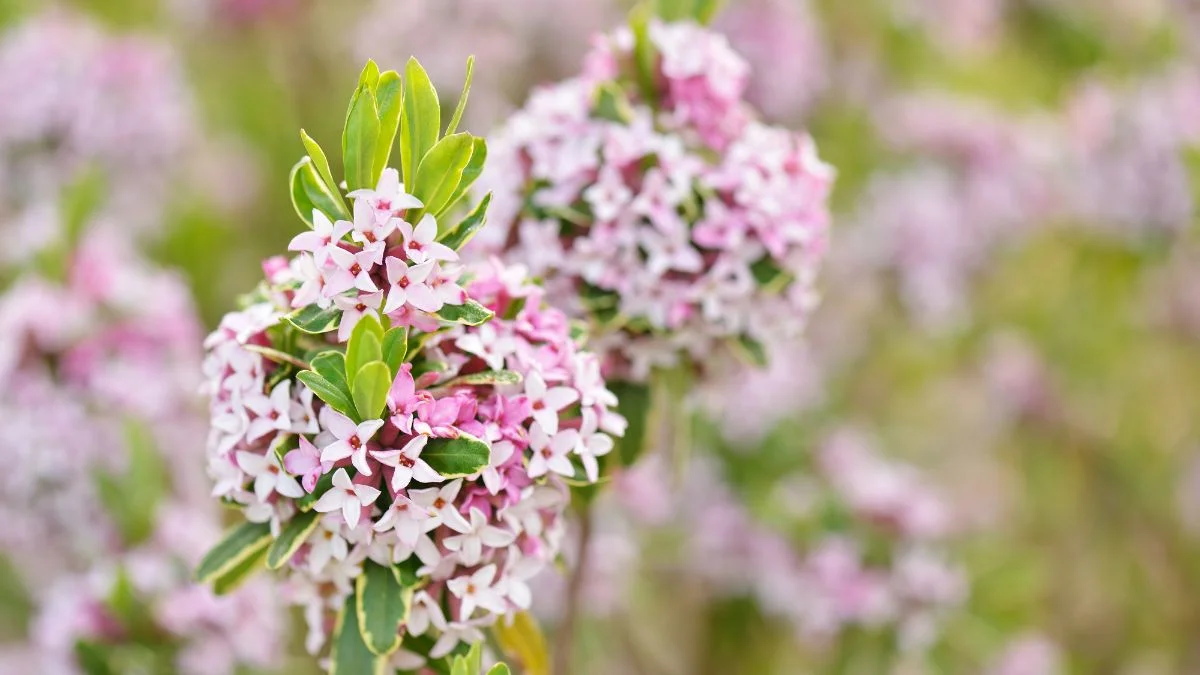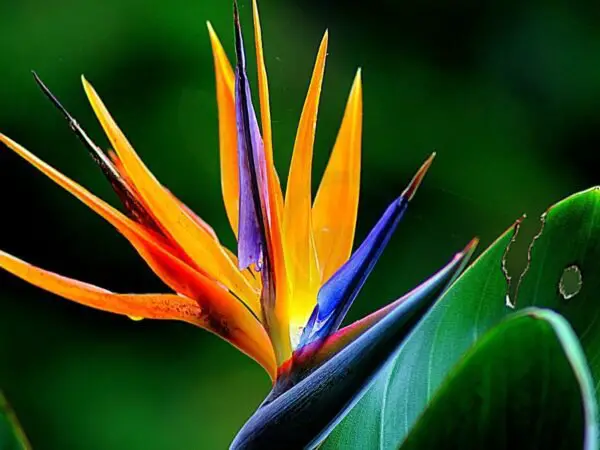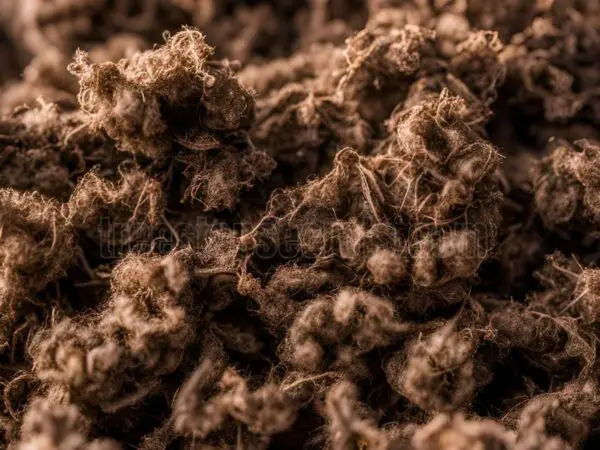The Carol Mackie Daphne plant, a beloved garden favorite, is renowned for its variegated foliage and fragrant flowers. This ornamental shrub adds a touch of elegance to any landscape with its compact size and year-round interest. Originally introduced in the 1960s by horticulturist Carol Mackie, this plant has stood the test of time and continues to captivate gardeners worldwide.
Discover Daphne x burkwoodii ‘Carol Mackie’
Plant Profile
The 'Carol Mackie' Daphne plant was discovered by Carol Mackie in the United States. It is known for its variegated foliage and ability to thrive in cold climates. This unique plant features green leaves with creamy-yellow edges.
The 'Carol Mackie' Daphne typically grows to a height of 2-3 feet with a spread of 2-4 feet. Its compact, rounded form makes it an excellent choice for borders or containers.
Growth Habits
For optimal growth, 'Carol Mackie' Daphne prefers partial sun to full sun exposure and well-draining soil. It blooms in late spring to early summer, producing clusters of fragrant pink flowers that attract pollinators.
This daphne may experience a second blooming period in late summer or early fall. Following the flowers, bright red fruits develop, adding ornamental value to the plant.
Care Requirements
To care for 'Carol Mackie' Daphne, ensure it is planted in well-drained soil to prevent waterlogging and root rot. This plant is also known for its resistance to deer browsing, making it a low-maintenance choice for gardens.
Water 'Carol Mackie' Daphne regularly but avoid overwatering as it can be sensitive to soggy conditions. Once established, this plant exhibits good drought tolerance, requiring minimal watering during dry spells.
Planting Guide for Carol Mackie Daphne
Best Locations
When planting Carol Mackie Daphne, choose locations with partial shade to protect it from intense sunlight. The plant thrives in areas with morning sun and afternoon shade. Ensure the spot has well-drained soil to prevent waterlogging.
For optimal growth, provide enough space between each Daphne plant. A spacing of around 2 to 3 feet allows proper air circulation and prevents overcrowding. This spacing promotes healthy growth and reduces the risk of diseases.
Heavy snow can have a detrimental effect on Carol Mackie Daphne if not properly protected. Excessive snow accumulation can lead to branches breaking or bending. To avoid damage, consider sheltered locations or use support structures during heavy snowfall.
Soil and Water Needs
Well-drained soil is crucial for the health of Carol Mackie Daphne plants. They prefer soil that is moist but not waterlogged. Good drainage prevents water from pooling around the roots, reducing the risk of root rot.
When it comes to watering, ensure that the soil is kept consistently moist but not soggy, especially during hot weather. Once established, Daphnes exhibit good drought tolerance, making them suitable for regions with sporadic rainfall.
Daphnes are susceptible to root rot if exposed to excessive moisture. To prevent this issue, maintain consistent moisture levels, allowing the soil to dry slightly between watering sessions. Proper drainage is key to avoiding water-related problems.
Planting Steps
To plant Carol Mackie Daphne successfully, start by selecting a location with partial shade and well-drained soil. Dig a hole that is twice as wide but just as deep as the plant's root ball.
Place the plant in the hole at the same depth it was growing in its container. Backfill with soil and gently pat down to remove air pockets. Water thoroughly after planting to help settle the soil around the roots.
Mulching around the base of the plant helps retain moisture and suppresses weed growth. Use organic mulch like wood chips or bark pieces, keeping it a few inches away from the stem to prevent rotting issues.
Maintenance and Care Tips
Pruning Techniques
Pruning 'Carol Mackie' Daphne regularly is crucial for its health and appearance. Trimming helps maintain a compact shape and encourages new growth. It also enhances air circulation, reducing the risk of diseases.
To prevent snow damage, prune your 'Carol Mackie' Daphne by removing any dead or damaged branches. Cutting back overgrown stems can prevent them from bending under heavy snow loads, preserving the plant's structure.
Careful pruning is essential to avoid bark damage, which can leave the plant vulnerable to infections. Use sharp, clean tools to make precise cuts near the branch collar without injuring the surrounding tissue.
Managing Pests
Common pests that may affect 'Carol Mackie' Daphne include aphids, scale insects, and spider mites. These pests can weaken the plant and cause leaf discoloration if left unchecked.
Implement strategies like regularly inspecting your plant for signs of pests and using organic insecticidal soap to control infestations. Encouraging natural predators like ladybugs can also help keep pest populations in check.
Early pest detection is vital for effective control. By catching pest issues early on, you can intervene promptly with appropriate treatments before the infestation spreads.
Seasonal Care
For 'Carol Mackie' Daphne, seasonal care varies throughout the year to support optimal growth and blooming. In spring, focus on pruning after flowering to shape the plant and remove dead wood.
Summer care involves watering deeply during dry spells to keep the soil consistently moist but not waterlogged. Mulching around the base helps retain moisture and suppresses weeds.
In fall, reduce watering frequency as temperatures cool down. Apply a layer of mulch to protect roots from winter frost and provide insulation against extreme cold.
Adjusting care routines based on seasonal changes ensures that 'Carol Mackie' Daphne thrives year-round with minimal stress from environmental factors.
Creative Garden Ideas
Landscape Design
When planning your garden, incorporate 'Carol Mackie' Daphne to add a touch of elegance. This plant's variegated leaves and fragrant flowers can enhance any landscape design. Experiment with placing it as a focal point or in clusters for visual interest.
To create a visually appealing garden, consider mixing 'Carol Mackie' Daphne with different garden styles. Whether you prefer a formal, structured look or a more relaxed, natural feel, this plant can adapt seamlessly. Its versatility allows it to complement various design themes.
The 'Carol Mackie' Daphne plays a crucial role in elevating the overall aesthetics of your landscape. With its compact size and vibrant foliage, it adds color and texture to the surroundings. Use it strategically to create balance and harmony in your garden design.
Companion Plants
When choosing companion plants for your garden, opt for ones that complement the beauty of 'Carol Mackie' Daphne. Consider pairing it with low-growing perennials like creeping phlox or ornamental grasses for a harmonious blend of colors and textures.
To enhance the visual appeal of your garden, pair 'Carol Mackie' Daphne with plants that have contrasting foliage or blooms. For example, combine it with purple heuchera or blue salvia to create striking color combinations that catch the eye.
Container Gardening
In container gardens, 'Carol Mackie' Daphne thrives in well-draining soil and partial shade conditions. Choose a container with drainage holes to prevent waterlogging and ensure proper root health. Regularly check the soil moisture levels to maintain optimal growing conditions.
For added visual impact in your container garden, combine 'Carol Mackie' Daphne with trailing plants like ivy or cascading petunias. This creates depth and dimension in your arrangement while allowing the daphne's beauty to shine through. Remember to fertilize periodically to support healthy growth.
Seasonal Gardening Tips
Spring is a crucial time for carol mackie daphne plants as they start to bloom with vibrant colors. Ensure to prune any dead branches to promote healthy growth and blossoming. fertilize the soil with a balanced fertilizer to provide essential nutrients.
During summer, regular watering is vital to keep the soil moist but not waterlogged. Mulching around the base of the plant helps retain moisture and suppresses weed growth. Deadhead faded flowers regularly to encourage continuous blooming throughout the season.
As autumn approaches, it's essential to prepare your carol mackie daphne plant for the winter ahead. Trim back any overgrown branches to maintain a compact shape and improve air circulation. Apply a layer of mulch around the base of the plant to protect its roots from frost during the colder months.
When winter arrives, it's crucial to protect your carol mackie daphne plant from harsh weather conditions. Consider wrapping the plant in burlap or providing a windbreak to shield it from strong winds. Avoid heavy pruning during this time as it can leave the plant vulnerable to cold damage.
Troubleshooting Common Issues
Leaf Drop
Leaf drop in Carol Mackie Daphne plants can be caused by overwatering, leading to root rot. Ensure proper drainage to prevent this issue. Lack of sunlight can also result in leaf drop, so place the plant in a spot with adequate light.
leaf drop might occur due to sudden temperature changes. Protect the plant from extreme temperature fluctuations to maintain its health and prevent leaf loss. Regularly inspect the leaves for any signs of pests or diseases that could be causing the issue.
Fading Fragrance
If you notice a fading fragrance in your Carol Mackie Daphne plant, it could be due to inadequate sunlight. Ensure the plant receives enough sunlight to enhance its fragrance. Prune the plant regularly to promote new growth and maintain its aromatic scent.
Moreover, fading fragrance can be a sign of nutrient deficiency. Consider feeding the plant with a balanced fertilizer suitable for flowering plants. Avoid over-fertilizing as it can lead to issues like burnt roots or excessive foliage growth instead of flowers.
Disease Management
Proper disease management is crucial for maintaining the health of Carol Mackie Daphne plants. To prevent fungal diseases, avoid overhead watering and ensure good air circulation around the plant. Remove any infected leaves promptly to stop the spread of disease.
Implementing a regular inspection routine is essential for early detection of any disease management issues. Treat any pest infestations immediately using organic solutions or insecticidal soap. Prune affected areas and dispose of them properly to prevent further contamination.
Enhancing Your Garden’s Appeal
Fragrance and Color
Carol Mackie Daphne plants are prized for their fragrant blooms and vibrant foliage, adding a delightful sensory experience to your garden. The clusters of pinkish-white flowers emit a sweet fragrance that attracts pollinators like bees.
These plants also boast variegated leaves, with hues ranging from green to yellow, creating a striking contrast in your garden. The evergreen nature of Carol Mackie Daphne ensures a pop of color throughout the year.
Year-Round Interest
With Carol Mackie Daphne in your garden, you can enjoy year-round interest due to their unique characteristics. During the spring and summer, the plant showcases its beautiful pinkish-white flowers, enhancing the visual appeal of your garden.
In the colder months, the evergreen foliage remains intact, providing structure and color even when other plants may be dormant. This ensures that your garden maintains its allure no matter the season.
Ask Your Gardening Question
FAQs Compilation
Have burning questions about Carol Mackie Daphne plants? Here are some common queries answered:
- How often should I water my Carol Mackie Daphne plant?
- What type of soil is best for Carol Mackie Daphne plants?
- How can I propagate Carol Mackie Daphne plants successfully?
Wondering about the ideal sunlight requirements for these plants? They thrive in partial shade, making them perfect for gardens with varying light conditions. They prefer well-draining soil to prevent root rot.
Expert Advice
Looking to ensure your Carol Mackie Daphne plant thrives? Consider the following expert tips:
- Plant your Daphne in a location with good air circulation to prevent fungal diseases.
- Prune your plant after flowering to maintain its shape and encourage new growth.
- Fertilize sparingly in the spring with a balanced fertilizer to support healthy growth.
Remember, these plants are prized for their fragrant flowers and variegated foliage, so providing proper care is key to enjoying their beauty year after year.
Latest Horticulture News
Research Updates
Research on Carol Mackie Daphne plants continues to reveal exciting findings. Recent studies have shown that these plants thrive in well-drained, fertile soil. They prefer partial shade and require minimal pruning to maintain their compact size. Experts recommend fertilizing them lightly in early spring for optimal growth.
- Key Points:
- Thrive in well-drained, fertile soil.
- Prefer partial shade.
- Minimal pruning needed.
- Light fertilization in early spring.
Ongoing research also indicates that Carol Mackie Daphne plants are resistant to most pests and diseases. This resilience makes them a low-maintenance option for gardeners looking to add a pop of color and fragrance to their landscape without constant monitoring or treatments. Their adaptability to various climates further enhances their appeal among horticulture enthusiasts.
Trending Garden Designs
Carol Mackie Daphne plants are increasingly being incorporated into modern garden designs due to their versatility and aesthetic appeal. Gardeners are creatively using these plants as focal points in rock gardens or as border shrubs along pathways. Their fragrant blooms attract pollinators, adding life and movement to outdoor spaces.
- Innovative Uses:
- Focal points in rock gardens.
- Border shrubs along pathways.
- Pollinator-friendly blooms.
Moreover, the variegated foliage of Carol Mackie Daphne plants provides year-round visual interest, making them a popular choice for landscaping projects aiming for continuous color and texture variation. Whether used in small urban gardens or expansive rural landscapes, these plants offer a touch of elegance and charm that captivates both novice and experienced gardeners alike.
Where to Find Carol Mackie Daphne Plants
Online Sources
When searching for Carol Mackie Daphne plants online, consider reputable websites like Gardener's Supply Company or Monrovia. These sites offer a vast selection of plants and provide detailed information about each plant, including care instructions.
You can also explore online plant marketplaces such as Etsy or eBay for unique finds and potential deals on Carol Mackie Daphne plants. Make sure to read reviews from other buyers to ensure the quality of the plants before making a purchase.
Local Nurseries
Visiting local nurseries is an excellent way to find Carol Mackie Daphne plants in your area. Nurseries like Green Acres Nursery & Supply or Pike Nurseries often carry a variety of rare and popular plants, including the sought-after Carol Mackie Daphne.
Local nurseries provide the advantage of being able to physically inspect the plants before buying them. You can assess the health and size of the plant, ensuring you get a high-quality specimen for your garden.
Final Remarks
Incorporate the tips and tricks you've learned to cultivate a thriving Carol Mackie Daphne plant. Ensure your garden radiates beauty and fragrance all year round by following the planting guide, maintenance suggestions, and creative garden ideas provided. Troubleshoot common issues effectively and enhance your garden's appeal with finesse. Stay updated with the latest horticulture news to keep your gardening skills sharp.
Now that you're equipped with expert knowledge on nurturing Carol Mackie Daphne plants, put your newfound wisdom into practice and watch your garden flourish. Share your gardening journey with fellow enthusiasts and continue exploring innovative ways to elevate your gardening experience.
Frequently Asked Questions
How to Plant Carol Mackie Daphne for Optimal Growth?
To plant Carol Mackie Daphne:
- Choose a well-draining location with partial shade.
- Dig a hole twice the size of the root ball.
- Mix organic matter into the soil.
- Place the plant at the same level as it was in the container.
- Water thoroughly after planting.
Is Carol Mackie Daphne Suitable for Container Gardening?
Yes, Carol Mackie Daphne is suitable for container gardening if you:
- Use a well-draining pot with drainage holes.
- Use a high-quality potting mix.
- Place the container in a location with partial shade.
- Water regularly to keep the soil moist but not waterlogged.
How to Maintain and Care for Carol Mackie Daphne?
To maintain and care for Carol Mackie Daphne:
- Prune lightly after flowering to maintain shape.
- Mulch around the base to retain moisture.
- Avoid heavy pruning as it can affect blooming.
- Fertilize lightly in spring with a balanced fertilizer.
- Monitor for pests and diseases regularly.
When is the Best Time to Plant Carol Mackie Daphne?
The best time to plant Carol Mackie Daphne is in early spring or fall when temperatures are moderate. This allows the plant to establish its roots before facing extreme weather conditions.
What Are Common Issues Faced When Growing Carol Mackie Daphne?
Common issues when growing Carol Mackie Daphne include:
- Yellowing leaves due to overwatering or nutrient deficiencies.
- Lack of blooming caused by improper pruning or insufficient sunlight.
- Root rot from waterlogged soil conditions.
- Pest infestations like aphids or spider mites.
Can I Propagate Carol Mackie Daphne at Home?
Yes, you can propagate Carol Mackie Daphne through semi-hardwood cuttings taken in late summer. Follow these steps:
- Take 4–6 inch cuttings from healthy stems.
- Remove lower leaves and dip cut ends in rooting hormone.
- Plant in a well-draining medium and keep moist until roots develop.
Image Source: Paid image from CANVA




